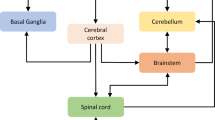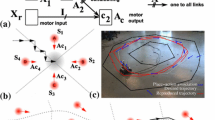Abstract
In order to control voluntary movements, the central nervous system (CNS) must solve the following three computational problems at different levels: the determination of a desired trajectory in the visual coordinates, the transformation of its coordinates to the body coordinates and the generation of motor command. Based on physiological knowledge and previous models, we propose a hierarchical neural network model which accounts for the generation of motor command. In our model the association cortex provides the motor cortex with the desired trajectory in the body coordinates, where the motor command is then calculated by means of long-loop sensory feedback. Within the spinocerebellum — magnocellular red nucleus system, an internal neural model of the dynamics of the musculoskeletal system is acquired with practice, because of the heterosynaptic plasticity, while monitoring the motor command and the results of movement. Internal feedback control with this dynamical model updates the motor command by predicting a possible error of movement. Within the cerebrocerebellum — parvocellular red nucleus system, an internal neural model of the inverse-dynamics of the musculo-skeletal system is acquired while monitoring the desired trajectory and the motor command. The inverse-dynamics model substitutes for other brain regions in the complex computation of the motor command. The dynamics and the inverse-dynamics models are realized by a parallel distributed neural network, which comprises many sub-systems computing various nonlinear transformations of input signals and a neuron with heterosynaptic plasticity (that is, changes of synaptic weights are assumed proportional to a product of two kinds of synaptic inputs). Control and learning performance of the model was investigated by computer simulation, in which a robotic manipulator was used as a controlled system, with the following results: (1) Both the dynamics and the inverse-dynamics models were acquired during control of movements. (2) As motor learning proceeded, the inverse-dynamics model gradually took the place of external feedback as the main controller. Concomitantly, overall control performance became much better. (3) Once the neural network model learned to control some movement, it could control quite different and faster movements. (4) The neural netowrk model worked well even when only very limited information about the fundamental dynamical structure of the controlled system was available. Consequently, the model not only accounts for the learning and control capability of the CNS, but also provides a promising parallel-distributed control scheme for a large-scale complex object whose dynamics are only partially known.
Similar content being viewed by others
References
Albus JS (1971) A theory of cerebellar functions. Math Biosci 10:25–61
Albus JS (1975) A new approach to manipulator control: the cerebellar model articulation controller (CMAC). J Dyn Syst Meas Control 97:270–277
Allen GI, Tsukahara N (1974) Cerebrocerebellar communication systems. Physiol Rev 54:957–1006
Amari S (1977) Neural theory of association and conceptformation. Biol Cybern 26:175–185
Arbib MA (1981) Perceptual structures and distributed motor control. In: Brooks VB (ed) Handbook of physiology, sect 1: vol 11, part 2. American Physiol Soc, Bethesda, pp 1449–1480
Arimoto S, Kawamura S, Miyazaki F (1984a) Bettering operation of dynamic systems by learning: a new control theory for sevomechanism or mechatronics systems. 23rd IEEE Conf Des Control 2:1064–1069
Arimoto S, Kawamura S, Miyazaki F (1984b) Can mechanical robots learn by themselves; Proceedings of 2nd International Symposium on Robotics Research, Kyoto, Japan
Cheney PD, Fetz EE (1980) Functional classes of primate corticomotoneuronal cells and their relation to active force. J Neurophysiol 44:773–791
Dubowsky S, DesForges DT (1979) The application of model reference adaptive control to robotic manipulators. J Dyn Syst Meas Control 101:193–200
Eccles JC: Introductory remarks In: Massion J, Sasaki K (eds) Cerebro-cerebellar interactions, pp 1–18. North-Holland Elsevier, Amsterdam Oxford New York, pp 1–18
Evarts EV (1981) Role of motor cortex in voluntary movements in primates. In: Brooks VB (ed) Handbook of physiology, sect 1: vol 11, part 2. American Physiol Soc, Bethesda, pp 1083–1120
Geman S (1979) Some averaging and stability results for random differential equations. SIAM J Appl Math 36:86–105
Ghez C, Fahn S (1985) The cerebellum. In: Kandel ER, Schwartz JH (eds) Principles of neural science. Elsevier, New York, pp 502–522
Bilbert PFC, Thach WT (1977) Purkinje cell activity during motor learning. Brain Res 128:309–328
Flash T, Hogan N (1985) The coordination of arm movements; an experimentally confirmed mathematical model. J Neurosci 5:1688–1703
Fujita M (1982a) Adaptive filter model of the cerebellum. Biol Cybern 45:195–206
Fujita M (1982b) Simulation of adaptive modification of the vestibulo-ocular reflex with an adaptive filter model of the cerebellum. Biol Cybern 45:207–214
Furukawa K (1984) Identification of a robotic manipulator by a neural model. Osaka Univ, Bachelor's Thesis
Hollerbach JM (1980) A recursive Lagrangian formulation of manipulator dynamics and a comparative study of dynamics formulation complexity. IEEE Trans SMC-10:730–736
Hollerbach JM (1982) Computers, brains and the control of movement. Trends Neuro Sci 5:189–192
Ito M (1970) Neurophysiological aspects of the cerebellar motor control system. Int J Neurol 7:162–176
Ito M (1984) The cerebellum and neural control. Raven Press, New York
Ito M, Shiida T, Yagi N, Yamamoto M (1974) The cerebellar modification of rabbit's horizontal vestibulo-ocular reflex induced by sustained head rotation combined with visual stimulation. Proc Jpn Acad 50:85–89
Ito M, Jastreboff PJ, Miyashita Y (1982) Specific effects of unilateral lesions in the flocculus upon eye movements in albino rabbits. Exp Brain Res 45:233–242
Ito M, Sakurai M, Tongroach P (1982) Climbing fibre induced depression of both mossy fibre responsiveness and gultamate sensitivity of cerebellar Purkinje cells. J Physiol 324:113–134
Kawato M, Hamaguchi T, Murakami F, Tsukahara N (1984) Quantitative analysis of electrical properties of dendritic spines. Biol Cybern 50:447–454
Llinás R, Walton K, Hillman D, Sotelo C (1975) Inferior olive: its role in motor learning. Science 190:1230–1231
Luh JYS, Walker MW, Paul RPC (1980) On-line computational scheme for mechanical manipulations. J Dyn Syst Meas Control 102:69–76
Marr D (1969) A theory of cerebellar cortex. J Physiol 202:437–470
Marr D (1982) Vision. Freeman, New York
Miyamoto H (1985) A motor learning model based on synaptic plasticity. Osaka University, Bachelor's Thesis
Miyamoto H, Kawato M, Suzuki R (1987) Hierarchical learning control of an industrial manipulator using a model of the central nervous system, Japan IEICE Technical Report, MBE-86-81:25–32
Poggio T, Torre V (1981) A theory of synaptic interactions. In: Reichardt WE, Poggio T (eds) Theoretical approaches in neurobiology. MIT Press, Cambridge, pp 28–46
Poirier LJ, Bouvier G, Bédard P, Bouchard R, Larochelle L, Olivier A, Singh P (1969) Essai sur les cirvuits neuronaux mipliqués dans le tremblement postural et l'hypokinesie. Rev Neurol 120:15–40
Raibert MH (1978) A model for sensorimotor control and learning. Biol Cybern 29:29–36
Sasaki K, Gemba H (1982) Development and change of cortical field potentials during learning processes of visually initiated hand movements in the monkey. Exp Brain Res 48:429–437
Sasaki K, Gemba H, Mizuno N (1982) Cortical field potentials preceding visually initiated hand movements and cerebellar actions in the monkey. Exp Brain Res 46:29–36
Setoyama T (1987) Symbolic calculation of subsystems of the neural inverse-dynamics model for a 6 degrees of freedom manipulator using REDUCE. Osaka University, Bachelor's Thesis
Tsukahara N (1981) Synaptic plasticity in the mammalian central nervous system. Annu Rev Neurosci 4:351–379
Tsukahara N, Kawato M (1982) Dynamic and plastic properties of the brain stem neuronal networks as the possible neuronal basis of learning and memory. In: Amari S, Arbib MA (eds) Competition and cooperation in neural nets. Springer, Berlin Heidelberg New York, pp 430–441
Tsukahara N, Oda Y, Notsu T (1981) Classical conditioning mediated by the red nucleus in the cat. J Neurosci 1:72–79
Uno Y, Kawato M, Suzuki R (1987) Formation of optimum trajectory in control of arm movement — minimum torquechange model — Japan IEICE Technical Report MBE 86-79:9–16
Widrow B, McCool JM, Larimore MG, Johnson CR (1976) Stationary and nonstationary learning characteristics of the LMS adaptive filter. Proc IEEE 64:1151–1162
Wilson HR, Cowan JD (1972) Excitatory and inhibitory interactions in localized populations of model neurons. Biophys J 12:1–24
Author information
Authors and Affiliations
Rights and permissions
About this article
Cite this article
Kawato, M., Furukawa, K. & Suzuki, R. A hierarchical neural-network model for control and learning of voluntary movement. Biol. Cybern. 57, 169–185 (1987). https://doi.org/10.1007/BF00364149
Received:
Issue Date:
DOI: https://doi.org/10.1007/BF00364149




